Motorola Solutions 89FT7027 Handheld Computer w/ Dual-Band GPRS, WLAN & BT User Manual Enhanced IMD Users
Motorola Solutions, Inc. Handheld Computer w/ Dual-Band GPRS, WLAN & BT Enhanced IMD Users
Contents
- 1. Exhibit 8a Supplemental Users Manual
- 2. Exhibit 8 Users Manual 1
- 3. Exhibit 8 Users Manual 2
Exhibit 8 Users Manual 1
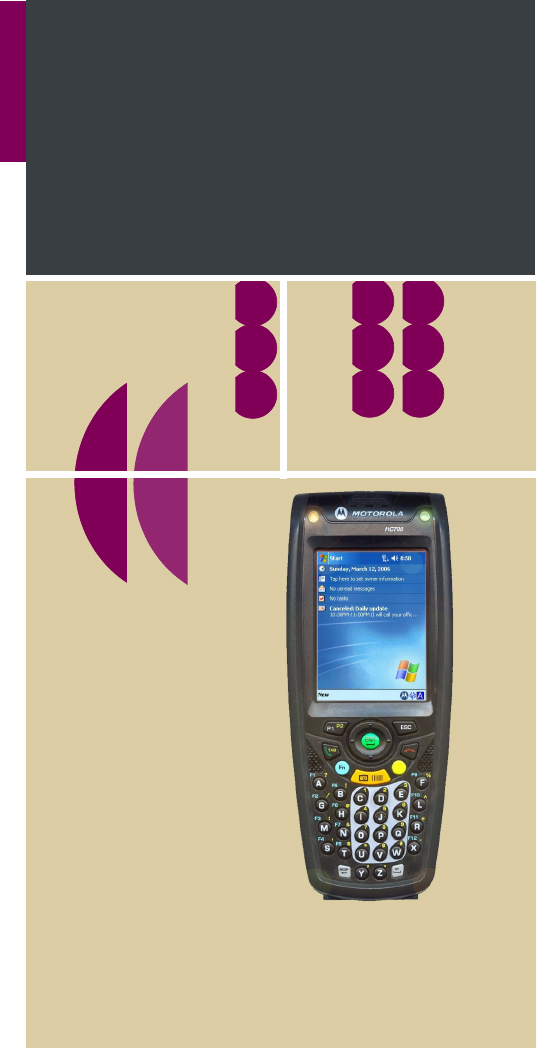
HC700-G & HCe700-G
Handheld Computers
Models:
F4708A (HC700-G) & F4707A (HCe700-G)
Quick Start Guide
a
Enhanced IMD Users.book Page 1 Monday, February 12, 2007 11:46 AM
Enhanced IMD Users.book Page 2 Monday, February 12, 2007 11:46 AM

i
COMPUTER SOFTWARE COPYRIGHTS
The Motorola products described in this instruction manual may
include copyrighted Motorola computer programs stored in semicon-
ductor memories or other media. Laws in the United States and other
countries preserve for Motorola certain exclusive rights for copy-
righted computer programs, including the exclusive right to copy or
reproduce in any form the copyrighted computer program. Accord-
ingly, any copyrighted Motorola computer programs contained In the
Motorola products described in this instruction manual may not be
copied or reproduced in any manner without the express written per-
mission of Motorola. Furthermore, the purchase of Motorola products
shall not be deemed to grant either directly or by implication, estop-
pel. or otherwise. any license under the copyrights, patents or patent
applications of Motorola, except for the normal non-exclusive, royalty
free license to use that arises by operation of law in the sale of a
product.
EPS – 34440- B
This warranty applies within the fifty (50) United States, the District of
Columbia and Canada.
Document Copyrights
No duplication or distribution of this document or any portion thereof
shall take place without the express written permission of Motorola.
No part of this manual may be reproduced, distributed, or transmitted
in any form or by any means, electronic or mechanical, for any pur-
pose without the express written permission of Motorola.
Disclaimer
The information in this document is carefully examined, and is
believed to be entirely reliable. However, no responsibility is
assumed for inaccuracies.
Furthermore, Motorola reserves the right to make changes to any
products herein to improve readability, function, or design. Motorola
does not assume any liability arising out of the applications or use of
any product or circuit described herein; nor does it cover any license
under its patent rights nor the rights of others.
Commercial Warranty
Limited Warranty
MOTOROLA COMMUNICATION PRODUCTS
I. What This Warranty Covers And For How Long
MOTOROLA INC. (“MOTOROLA”) warrants the MOTOROLA manu-
factured Communication Products listed below (“Product”) against
defects in material and workmanship under normal use and service
for a period of time from the date of purchase as scheduled below:
HC700-G unit One (1) Year
Product Accessories One (1) Year
Enhanced IMD Users.book Page i Monday, February 12, 2007 11:46 AM
ii
Motorola, at its option, will at no charge either repair the Product (with
new or reconditioned parts), replace it (with a new or reconditioned
Product), or refund the purchase price of the Product during the war-
ranty period provided it is returned in accordance with the terms of
this warranty. Replaced parts or boards are warranted for the bal-
ance of the original applicable warranty period. All replaced parts of
Product shall become the property of MOTOROLA.
This express limited warranty is extended by MOTOROLA to the
original end user purchaser only and is not assignable or transferable
to any other party. This is the complete warranty for the Product man-
ufactured by MOTOROLA. MOTOROLA assumes no obligations or
liability for additions or modifications to this warranty unless made in
writing and signed by an officer of MOTOROLA. Unless made in a
separate agreement between MOTOROLA and the original end user
purchaser, MOTOROLA does not warrant the installation, mainte-
nance or service of the Product.
MOTOROLA cannot be responsible in any way for any ancillary
equipment not furnished by MOTOROLA which is attached to or
used in connection with the Product, or for operation of the Product
with any ancillary equipment, and all such equipment is expressly
excluded from this warranty. Because each system which may use
the Product is unique, MOTOROLA disclaims liability for range, cov-
erage, or operation of the system as a whole under this warranty.
II. General Provisions
This warranty sets forth the full extent of MOTOROLA’s responsibili-
ties regarding the Product. Repair, replacement or refund of the pur-
chase price, at MOTOROLA’s option, is the exclusive remedy. THIS
WARRANTY IS GIVEN IN LIEU OF ALL OTHER EXPRESS WAR-
RANTIES. IMPLIED WARRANTIES, INCLUDING WITHOUT LIMI-
TATION, IMPLIED WARRANTIES OF MERCHANTABILITY AND
FITNESS FOR A PARTICULAR PURPOSE, ARE LIMITED TO THE
DURATION OF THIS LIMITED WARRANTY. IN NO EVENT SHALL
MOTOROLA BE LIABLE FOR DAMAGES IN EXCESS OF THE
PURCHASE PRICE OF THE PRODUCT, FOR ANY LOSS OF USE,
LOSS OF TIME, INCONVENIENCE, COMMERCIAL LOSS, LOST
PROFITS OR SAVINGS OR OTHER INCIDENTAL, SPECIAL OR
CONSEQUENTIAL DAMAGES ARISING OUT OF THE USE OR
INABILITY TO USE SUCH PRODUCT, TO THE FULL EXTENT
SUCH MAY BE DISCLAIMED BY LAW.
III. State Law Rights
SOME STATES DO NOT ALLOW THE EXCLUSION OR LIMITA-
TION OF INCIDENTAL OR CONSEQUENTIAL DAMAGES OR LIMI-
TATION ON HOW LONG AN IMPLIED WARRANTY LASTS, SO
THE ABOVE LIMITATION OR EXCLUSIONS MAY NOT APPLY.
This warranty gives specific legal rights, and there may be other
rights which may vary from state to state.
Enhanced IMD Users.book Page ii Monday, February 12, 2007 11:46 AM
iii
IV. How To Get Warranty Service
You must provide proof of purchase (bearing the date of purchase
and Product item serial number) in order to receive warranty service
and, also, deliver or send the Product item, transportation and insur-
ance prepaid, to an authorized warranty service location. Warranty
service will be provided by Motorola through one of its authorized
warranty service locations. If you first contact the company which
sold you the Product, it can facilitate your obtaining warranty service.
You can also call Motorola at 1-888-567-7347 US/Canada.
V. What This Warranty Does Not Cover
A. Defects or damage resulting from use of the Product in
other than its normal and customary manner.
B. Defects or damage from misuse, accident, water, or
neglect.
C. Defects or damage from improper testing, operation,
maintenance, installation, alteration, modification, or
adjustment.
D. Breakage or damage to antennas unless caused
directly by defects in material workmanship.
E. A Product subjected to unauthorized Product modifica-
tions, disassemblies or repairs (including, without limi-
tation, the addition to the Product of non-Motorola
supplied equipment) which adversely affect perfor-
mance of the Product or interfere with Motorola's nor-
mal warranty inspection and testing of the Product to
verify any warranty claim.
F. Product which has had the serial number removed or
made illegible.
G. Rechargeable batteries if:
•any of the seals on the battery enclosure of cells are bro-
ken or show evidence of tampering.
•the damage or defect is caused by charging or using the
battery in equipment or service other than the Product
for which it is specified.
H. Freight costs to the repair depot.
I. A Product which, due to illegal or unauthorized alteration
of the software/firmware in the Product, does not func-
tion in accordance with MOTOROLA’s published speci-
fications or the FCC type acceptance labeling in effect
for the Product at the time the Product was initially dis-
tributed from MOTOROLA.
J. Scratches or other cosmetic damage to Product sur-
faces that does not affect the operation of the Product.
K. Normal and customary wear and tear.
Enhanced IMD Users.book Page iii Monday, February 12, 2007 11:46 AM
iv
VI. Patent And Software Provisions
MOTOROLA will defend, at its own expense, any suit brought
against the end user purchaser to the extent that it is based on a
claim that the Product or parts infringe a United States patent, and
MOTOROLA will pay those costs and damages finally awarded
against the end user purchaser in any such suit which are attribut-
able to any such claim, but such defense and payments are condi-
tioned on the following:
A. that MOTOROLA will be notified promptly in writing by
such purchaser of any notice of such claim;
B. that MOTOROLA will have sole control of the defense of
such suit and all negotiations for its settlement or com-
promise; and
C. should the Product or parts become, or in MOTOR-
OLA’s opinion be likely to become, the subject of a
claim of infringement of a United States patent, that
such purchaser will permit MOTOROLA, at its option
and expense, either to procure for such purchaser the
right to continue using the Product or parts or to replace
or modify the same so that it becomes noninfringing or
to grant such purchaser a credit for the Product or parts
as depreciated and accept its return. The depreciation
will be an equal amount per year over the lifetime of the
Product or parts as established by MOTOROLA.
MOTOROLA will have no liability with respect to any claim of patent
infringement which is based upon the combination of the Product or
parts furnished hereunder with software, apparatus or devices not
furnished by MOTOROLA, nor will MOTOROLA have any liability for
the use of ancillary equipment or software not furnished by MOTOR-
OLA which is attached to or used in connection with the Product. The
foregoing states the entire liability of MOTOROLA with respect to
infringement of patents by the Product or any parts thereof.
Laws in the United States and other countries preserve for MOTOR-
OLA certain exclusive rights for copyrighted MOTOROLA software
such as the exclusive rights to reproduce in copies and distribute
copies of such Motorola software. MOTOROLA software may be
used in only the Product in which the software was originally embod-
ied and such software in such Product may not be replaced, copied,
distributed, modified in any way, or used to produce any derivative
thereof. No other use including, without limitation, alteration, modifi-
cation, reproduction, distribution, or reverse engineering of such
MOTOROLA software or exercise of rights in such MOTOROLA soft-
ware is permitted. No license is granted by implication, estoppel or
otherwise under MOTOROLA patent rights or copyrights.
VII. Governing Law
This Warranty is governed by the laws of the State of Illinois, USA.
EPS – 48759 – O
Enhanced IMD Users.book Page iv Monday, February 12, 2007 11:46 AM
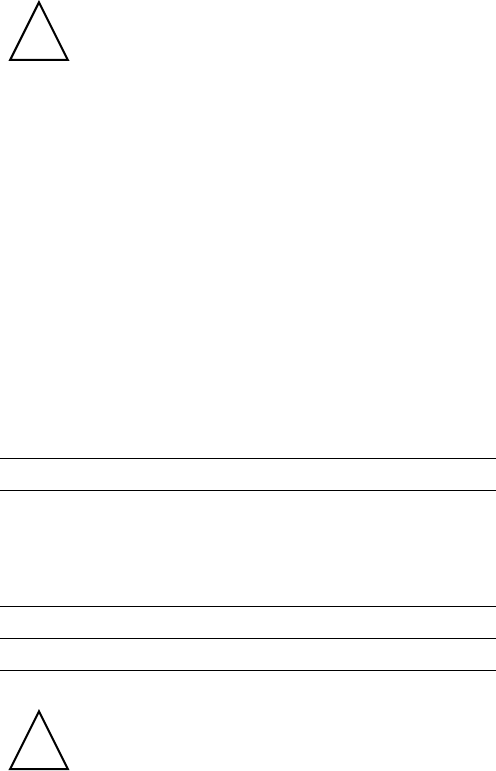
v
Notational Conventions
Throughout this publication, you will notice the use of cautions and
notes. These notations are used to emphasize that safety hazards
exist, and care must be taken.
CAUTION
Do not proceed beyond a CAUTION until the indicated conditions are
fully understood and met.
Equipment Authorization
IMPORTANT: Unauthorized repairs or modifications could result in
permanent damage to the equipment and void your warranty and
your authority to operate this device under Part 15 of the FCC Rules.
• FCC ID: AZ489FT7027
• Industry Canada: 109U-89FT7027
This Class B digital apparatus complies with Canadian
ICES-003
Radio Frequency and Power
Indicates a potentially hazardous situation which, if not
avoided, may result in minor or moderate injury. CAU-
TION may also be used to alert against unsafe practices
and property-damage-only accident hazards.
Radio Network Frequency Band Rated Power
GPRS WAN GSM 850
TX 824.2 - 848.8 MHz
RX 869 - 894 MHz
PCS 1900
TX 1850.2 - 1909.8 MHz
RX 1930 - 1990 MHz
1.585 W
0.794 W
Wi-Fi 802.11b/g W-LAN 2412 - 2462 MHz 32 mW
Bluetooth W-PAN 2402 - 2480 MHz 1 mW
Changes or modifications made in the handheld com-
puter, not expressly approved by Motorola, will void
the user's authority to operate the equipment.
!
Caution
!
Caution
Enhanced IMD Users.book Page v Monday, February 12, 2007 11:46 AM

vi
Wi-Fi Certification
This product is certified: IEEE 802.11b, IEEE 802.11g, WPA, WPA2
and EAP.
FCC INTERFERENCE
This device complies with Part 15 of the FCC Rules. Operation is
subject to the following two conditions:
(1) This device may not cause harmful interference.
(2) This device must accept any interference received, including
interference that may cause undesired operation.
For detailed product safety and RF exposure refer to Safety and
General Information leaflet, Motorola publication Number
6802979C37.
Enhanced IMD Users.book Page vi Monday, February 12, 2007 11:46 AM

vii
DECLARATION OF CONFORMITY
Per FCC CFR 47 Part 2 Section 2.1077(a)
Responsible Party Name: Motorola, Inc.
Address: 8000 West Sunrise Boulevard, Plantation, FL 33328
USA
Phone Number: 1 (800) 453-0920
Hereby declares that the product:
Product Name: HC700G
Model Number: F4708A
Conforms to the following regulations:
FCC Part 15, subpart B
Class B Digital Device
Date: September 12th , 2006
NOTE: This equipment has been tested and found to comply
with the limits for a Class B digital device, pursuant to Part 15
of the FCC Rules. These limits are designed to provide rea-
sonable protection against harmful interference in a residen-
tial installation. This equipment generates, uses and can
radiate radio frequency energy and, if not installed and used
in accordance with the instructions, may cause harmful inter-
ference to radio communications. However, there is no guar-
antee that interference will not occur in a particular
installation.
If this equipment does cause harmful interference to radio or
television reception, which can be determined by turning the
equipment off and on, the user is encouraged to try to correct
the interference by one or more of the following measures:
• Reorient or relocate the receiving antenna.
• Increase the separation between the equipment and
receiver.
• Connect the equipment into an outlet on a circuit different
from that to which the receiver is connected.
• Consult the dealer or an experienced radio/TV technician
for help.
Enhanced IMD Users.book Page vii Monday, February 12, 2007 11:46 AM
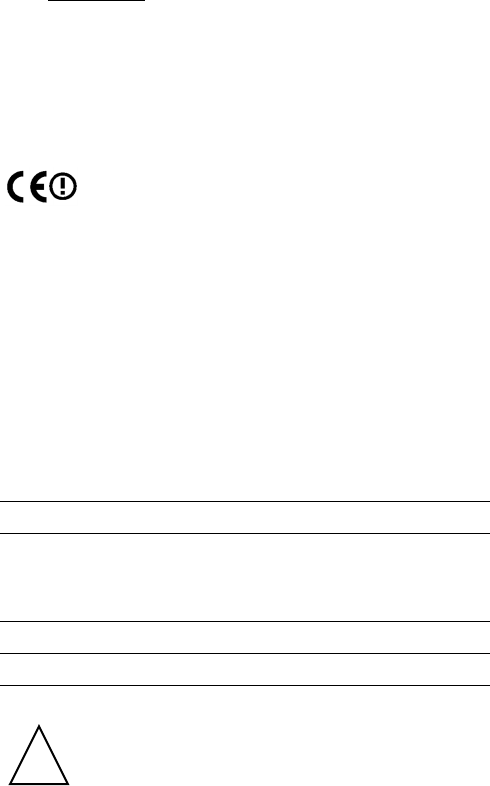
viii
HC700-G (US) Transmission Modes
HC700-G contains GPRS, WLAN and BT radios.
Below please find the radios transmitting combinations:
- Simultaneous transmission of the WAN (all bands) and WLAN
radios is not allowed when used in the present configuration.
- The WAN (all bands) and Bluetooth transmitters may work simulta-
neously when used in the present configuration.
- The WLAN and Bluetooth transmitters may work simultaneously
when used in the present configuration.
European Union Directives Conformance Statement
You can view your product's Declaration of Conformity (DoC) to
Directives 89/336/EEC and 73/23/EEC at www.motorola.com/rtte - to
find your DoC, enter the product Approval Number from your prod-
uct's label in the "Search" bar on the Web site.
This product conforms with the restriction of the use of certain haz-
ardous substances in electrical and electronic equipment (RoHS).
Please contact your supplier to view your product's RoHS informa-
tion.
Radio Frequency and Power
The CE Mark on the product indicates that this product
has been tested to and conforms with the provisions
noted within the 89/336/EEC Electromagnetic Compatibil-
ity Directive and the 73/23/EEC Low Voltage Directive.
Radio Network Frequency Band Rated Power
GPRS WAN GSM 900
880 - 960 MHz
DCS 1800
1710 - 1880 MHz
1.5 W
0.8 W
Wi-Fi 802.11b/g W-LAN 2412 - 2462 MHz 32 mW
Bluetooth W-PAN 2402 - 2480 MHz 1 mW
Changes or modifications made in the handheld com-
puter, not expressly approved by Motorola, will void
the user's authority to operate the equipment.
!
Caution
Enhanced IMD Users.book Page viii Monday, February 12, 2007 11:46 AM

ix
HCe700-G (EU) Transmission Modes
HC700-G contains GPRS, WLAN and BT radios.
Below please find the radios transmitting combinations:
- Simultaneous transmission of the GPRS (all bands) and WLAN
radios is not allowed when used in the present configuration.
- The GPRS (all bands) and Bluetooth transmitters may work simulta-
neously when used in the present configuration.
- The WLAN and Bluetooth transmitters may work simultaneously
when used in the present configuration.
France Indoor Only
Waste (Disposal) of your Electronic and
Electric Equipment
Trademarks
SD® is a registered trademark of SanDisk Corporation.
Microsoft® Windows® and ActiveSync® are either registered trade-
marks or trademarks of Microsoft Corporation in the United States
and/or other countries.
The BluetoothTM trademarks are owned by their proprietor and used
by Motorola, Inc. under license in the U.S. and other countries.
MOTOROLA and the Stylized M Logo are registered in the U.S.
Patent and Trademark Office. All other product or service names are
the property of their registered owners. © Motorola, Inc. 2007.
Note: Bluetooth features and Bluetooth Class 1 power
levels are not allowed for outdoor operation in France. To
avoid unlawful interference with radio signals, do not use
the Bluetooth features in France unless you are indoors.
European Union (EU) Waste of Electrical and Elec-
tronic Equipment (WEEE) directive
The European Union's WEEE directive requires that prod-
ucts sold into EU countries must have the crossed out
trashbin label on the product (or the package in some
cases). As defined by the WEEE directive, this cross-out
trashbin label means that customers and end-users in EU
countries should not dispose of electronic and electrical
equipment or accessories in household waste. Customers
or end-users in EU countries should contact their local
equipment supplier representative or service centre for
information about the waste collection system in their
country.
Enhanced IMD Users.book Page ix Monday, February 12, 2007 11:46 AM
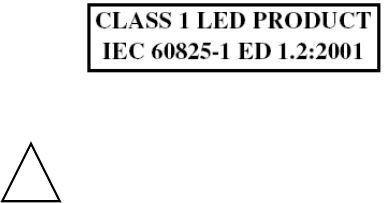
x
Eye Safety Standard for Imager Engines
The HC700-G and the HCe700-G is manufactured with the following
Imager Engine options:
- 5300 series with Laser aiming technology.
- 5100 series with light emitting diodes aiming technology.
Eye Safety Standard for 5100 Engine
The standard, "IEC 60825-1 Safety of Laser Products"1 ("Standard")
gives guidelines as to the acceptable brightness of lasers and LEDs.
This depends on how bright the LED is itself, but also how it is
arranged in a device. The Standard sets the acceptable levels of light
and testing conditions for the product. This Standard, like many oth-
ers, is written by a group of technical experts and undergoes a rigor-
ous approval process prior to adoption. One should also note that the
specifics of this Standard assume exposure conditions and distances
that present a worse case operation of the product as compared to
the typical and intended operation of this device. Class 1 instruments
are required to carry the following symbol either on the item, or in
manuals to indicate the level of safety when compared against the
Standard:
The Standard also recommends that the following be included in
user documentation:
Note: This warning states that altering the inner parts of the scanner
in a way not specified in the user guide may cause light
levels to exceed Class 1 limits. It is not an issue when using a hand
held scanner under normal conditions.
Eye Safety Standard for 5300 Series Engine
The standard, "IEC 60825-1 Safety of Laser Products”1 ("Standard")
gives guidelines as to the acceptable brightness of lasers and LEDs.
This depends on how bright the laser is itself, but also how it is
arranged in a device. The Standard sets the acceptable levels of light
and testing conditions for the product. This Standard, like many oth-
ers, is written by a group of technical experts and undergoes a rigor-
ous approval process prior to adoption. One should also note that the
specifics of this Standard assume exposure conditions and distances
Use of controls or adjustments or performance of proce-
dures other than those specified herein may result in
hazardous radiation exposure.
!
Caution
Enhanced IMD Users.book Page x Monday, February 12, 2007 11:46 AM
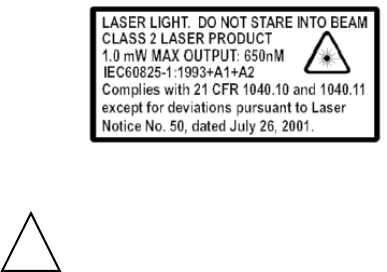
xi
that present a worse case operation of the product as compared to
the typical and intended operation of this device.
The Standard also recommends that the following be included in
user documentation:
Note: This warning states that altering the inner parts of the scanner
in a way not specified in the user guide may cause light levels to
exceed Class 2 limits. It is not an issue when using a hand held scan-
ner under normal conditions.
5100 engine LED Eye Safety Standard Compli-
ance
The 5100 engine have no lasers. The 5100 engine has light emitting
diodes (LEDs) that create the aimer line and illumination. These
LEDs are bright, but testing has been done to demonstrate that the
engine is safe for its intended application under normal usage condi-
tions.
The 5100 engine is certified as Class 1, the safest level. This level
includes relatively dim indicator LEDs and other sources that are
brighter than the 5100 engine. This means the engine is safe under
reasonably foreseeable conditions of operation2. The use and condi-
tions of operation are: the device is aimed at a bar code, and the LED
aimer and illumination pattern are activated. You may be exposed to
optical radiation for short periods without negative effects but, as with
any light source, you should avoid looking into the beam.
1. A copy of the Standard may be found at http://www.iec.ch.
2. Refer to IEC 60825-1 Ed 1.2, section 8.2.
Use of controls or adjustments or performance of proce-
dures other than those specified herein may result in
hazardous radiation exposure.
!
Caution
Enhanced IMD Users.book Page xi Monday, February 12, 2007 11:46 AM
xii
Enhanced IMD Users.book Page xii Monday, February 12, 2007 11:46 AM
© Motorola Inc., 2007 6802981C55-D
February, 2007
Contents
COMPUTER SOFTWARE COPYRIGHTS........ i
Document Copyrights........................................ i
Disclaimer.......................................................... i
Commercial Warranty........................................ i
Notational Conventions ..................................... v
Equipment Authorization ................................... v
Radio Frequency and Power............................. v
FCC INTERFERENCE ...................................... vi
HC700-G (US) Transmission Modes ................. viii
European Union Directives Conformance Statement viii
Radio Frequency and Power............................. viii
HCe700-G (EU) Transmission Modes ............... ix
Waste (Disposal) of your Electronic and Electric Equipment ix
Trademarks ....................................................... ix
Eye Safety Standard for Imager Engines .......... x
Welcome....................................................... 1
What is the HC700-G Handheld Computer? ..... 1
Unpacking ......................................................... 3
HC700-G Features ....................................... 4
Front Panel and Top Side Features................... 4
Rear and Bottom Side Features........................ 5
Charging the Battery..................................... 6
First Time Battery Charge ................................. 7
Checking the Remaining Battery Power............ 7
Routine Battery Charge..................................... 7
Battery Replacement......................................... 8
Battery Maintenance ......................................... 9
Battery Disposal ................................................ 10
Using the HC700-G ...................................... 11
Starting to Work................................................. 11
Turning Off......................................................... 11
Resuming Operation ......................................... 12
Suspend Mode .................................................. 12
The Status LED ................................................ 13
Enhanced IMD Users.book Page xiii Monday, February 12, 2007 11:46 AM
xiv
Using the Keypad .............................................. 15
Keypad Backlight............................................... 18
Screen Backlight ............................................... 18
Calibrating the Touch Screen ............................ 18
Adjusting Earpiece/Speaker Volume ................. 19
Voice Recording ................................................ 19
Resetting the HC700-G ..................................... 20
miniSD Memory Card ................................... 22
Installing a miniSD Card.................................... 22
miniSD Card Handling Precautions................... 22
Allocating Memory............................................. 22
Scanning Barcodes ...................................... 23
Scanning with LED aimer imager ...................... 23
Scanning with Laser aimer imager .................... 24
Using the Phone ........................................... 26
SIM Card Installation ......................................... 26
Switching on the phone ..................................... 27
Starting the Phone Application .......................... 27
Make a Call ....................................................... 28
Answer a Call .................................................... 28
Make a call using speed dial ............................. 28
Call Waiting ....................................................... 28
Create a Contact from a Call............................. 28
Make a conference call ..................................... 29
Display/hide your caller ID................................. 29
Block incoming/outgoing calls ........................... 29
Forward calls to a different phone ..................... 29
Use Call Waiting ................................................ 30
Turn the phone on and off (flight mode) ............ 30
Place a call on hold ........................................... 30
Speed Dial......................................................... 30
Change phone settings ..................................... 31
Change the ringer volume ................................. 31
Change the ring type ......................................... 32
Change the ring tone......................................... 32
Change services settings .................................. 32
Internet connection using GPRS network ......... 33
Enhanced IMD Users.book Page xiv Monday, February 12, 2007 11:46 AM
xv
Bluetooth Connection ................................... 34
Turning on/off..................................................... 34
Create a Bluetooth link (partnership)................. 34
Wireless LAN Connection............................. 36
Turning on/off..................................................... 36
Connection to the Internet ................................. 36
First time Connection to the Internet ................. 36
Connect to work ................................................ 37
Switching to a different wireless LAN ................ 37
Advance wireless operations............................. 37
ActiveSync (USB) Connectivity .................... 38
First Time Connection ....................................... 38
Routine Connection........................................... 38
Troubleshooting ........................................... 39
Service.......................................................... 42
Maintaining the HC700-G.................................. 42
Cleaning ............................................................ 42
Enhanced IMD Users.book Page xv Monday, February 12, 2007 11:46 AM
xvi
Blank Page
Enhanced IMD Users.book Page xvi Monday, February 12, 2007 11:46 AM
1
Welcome
Welcome to the world of Motorola digital wireless communi-
cations! We are pleased that you have chosen the Motorola
HC700-G GSM wireless Handheld Computer.
The HC700-G unique functionality and features make this
state-of-the-art device, superior for use in a wide range of
data collection and management applications.
This manual covers the basic operations and use of the
HC700-G. However, evaluation of the HC700-G performance
can be fully achieved by referring to Microsoft® Windows®
Mobile 2003 SE for Pocket PC Phone Edition documentation
and by using the demo software applications provided with
the HC700-G.
What is the HC700-G Handheld Computer?
The HC700-G is a rugged handheld computer. The HC700-G is
designed for field applications where Automatic Identifica-
tion and Data Capture (AIDC) is required.
The HC700-G has two models: the HC700-G model is the USA
version and the HCe700-G model is the European/Asian ver-
sion. This manual refers to all models as HC700-G.
The HC700-G serves as a Personal Digital Assistant (PDA)
that enables portable access to Microsoft® Windows®
Mobile 2003 SE for Pocket PC Phone Edition applications. It
contains a built-in imager (camera), capable of reading one of
the following barcode options: 1D or 1D and PDF or all 1D and
2D.
Wireless communication enables access to the outside world
through Global System for Mobile communication (GSM),
General Packet Radio Service (GPRS) and 802.11b/g Wireless
Local Area Network (WLAN, Wi-FiTM).
Data exchange with peripheral wireless equipment can be
established through Wireless Personal Area Network
(WPAN) using Bluetooth® radio. Personal wireless equipment
may include printers and body-worn devices.
Enhanced IMD Users.book Page 1 Monday, February 12, 2007 11:46 AM
2
When docked in a Personal Desktop Cradle, the HC700-G
supports full RS232 and USB (1.1 Client) serial communica-
tion with a host computer (USB via Microsoft® ActiveSync®)
or a dial-up modem. Ethernet connection can be established
through 10/100 base T interface via multi-bay communication
cradles.
The HC700-G is equipped with a QVGA 3.5 inch transflective
TFT display, built to withstand high impact. Display backlight
is designed to enable clear screen visibility under varied light
conditions.
A touch-screen enables easy on-screen menu navigation, in
addition to using keypad navigation. The keypad uses an
adjustable backlight illumination, designed for low-light
working conditions.
The HC700-G is powered by an 1800 mAh 7.2V Lithium-Ion
battery pack. The battery is fully recharged within four hours
when the HC700-G is docked in a cradle.
A drained battery can be replaced without data loss from the
HC700-G memory. A built-in power source, independent of
the battery pack, maintains the data in the HC700-G memory
for at least 30 minutes until a charged battery is placed.
The HC700-G may use a range of Motorola docking cradles
for network communications and power charging.
The Personal Desktop Cradle is designed for office use of the
HC700-G. The 8- and 4-bay charging/communication cradles
(HCC700-8, -4) provide multi-bay docking in large operations.
The Vehicle Cradle (HCV700) is used for the mobile applica-
tions of the HC700-G, allowing charging while driving.
For detailed installation and operation of each cradle, refer to
the specific user manual of each cradle.
Enhanced IMD Users.book Page 2 Monday, February 12, 2007 11:46 AM
3
Unpacking
The HC700-G basic package includes the following items:
•HC700-G
• 7.2V Lithium-Ion battery pack
•Stylus
• Hand-strap
• This Quick Start Guide
• Safety and General Information leaflet, Motorola P.N.
6802979C37
Optional items include:
• Personal Desktop Cradle with USB, RS232 pass through
and spare battery charging
• 4-slot Communication Cradle with RS232 and Ethernet
ports
• 8-slot Communication Cradle with RS232 and Ethernet
ports
• Vehicle Cradle with USB and RS232 pass through
• Vehicle Power Adapter 12V, quick disconnect
• Serial Cables DB25, DB9, quick disconnect
• Travel Charger 220/110Vac
• Belt/Shoulder Holster without shoulder strap
• Spare Stylus Pack of 5
• Spare Tethered Stylus Pack of 5
• Spare Hand Strap User replaceable
• 7.2V Lithium-Ion spare battery pack
Carefully unpack each item from the shipping carton. Check
all items for shipping damage, and check that you have
received all items ordered.
Note: Retain the original carton packaging in the event that
the HC700-G should need to be returned for service.
The HC700-G is shipped with a plastic film, protecting the
screen. Before usage, remove the film and use a soft cloth to
buff the screen. A clean screen ensures smooth gliding of the
stylus over the surface.
Enhanced IMD Users.book Page 3 Monday, February 12, 2007 11:46 AM
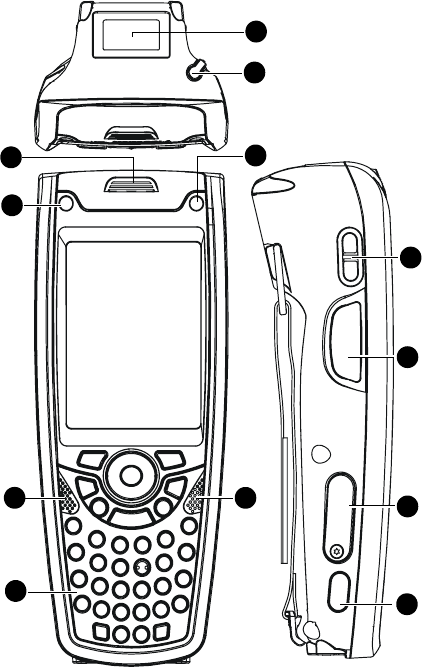
4
HC700-G Features
Front Panel and Top Side Features
Figure 1. HC700-G - Front and Top Views
1. Imager Window
2. Stylus Compartment
3. Power Button with Status LED (see page 11) & (see page 13)
4. Earpiece/Speaker Volume Keys (see page 19)
5. Scan/Picture Key (see page 23)
6. miniSD Card Door (see page 22)
7. IrDA Window (IrDA communication is not supported)
8. Speaker (see page 19)
9. Keypad (see page 15)
10. Microphone (see page 19)
11. Application LED (see page 14)
12. Earpiece (see page 19)
1
2
3
5
6
7
810
11
4
9
12
Enhanced IMD Users.book Page 4 Monday, February 12, 2007 11:46 AM
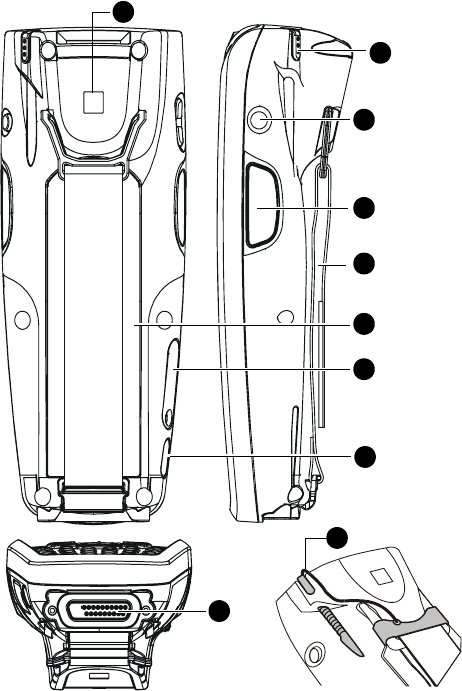
5
Rear and Bottom Side Features
Figure 2. HC700-G - Rear and Bottom Views
1. Bluetooth address identification label (Used to link the HC700-G
with another device using Bluetooth)
2. Stylus Compartment
3. Voice Recording Button (see page 19)
4. Scan/Picture Key
5. Hand-strap
6. Battery Pack (see page 8)
7. Access Door to the miniSD Memory Card (see page 22)
8. IrDA Window (IrDA communication is not supported)
9. Cradle Interface Connector
10. Tethered Stylus
1
2
3
5
6
7
8
9
4
10
Enhanced IMD Users.book Page 5 Monday, February 12, 2007 11:46 AM
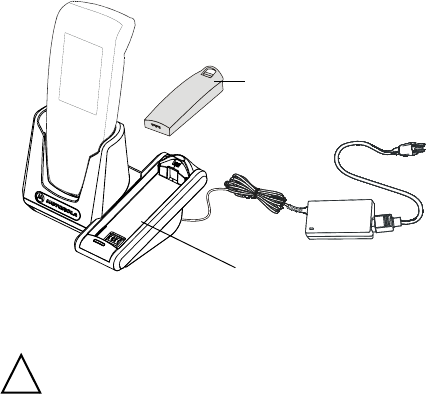
6
Charging the Battery
The battery is charged when the HC700-G is docked in the
cradle. When using a Personal Desktop Cradle, a spare bat-
tery can be charged in the battery charging bay. A fully
charged battery provides 10 hours of typical usage or 24
hours in Standby mode.
Always use Motorola HC700-G original batteries and battery
chargers. The HC700-G warranty does not cover damage
caused by using non-Motorola batteries and/or battery charg-
ers.
The following sections describe the installation and charging
of the battery of the HC700-G.
First Time Battery Charge
New batteries are shipped partially charged. Charge the bat-
tery before using the HC700-G for the first time.
• When not in use, always place the HC700-G in
a powered cradle. Leaving the HC700-G out of
the cradle may drain the battery, causing
memory lost from RAM
• To avoid battery damage, the battery must
never be allowed to remain totally drained for
over a period of one week
Figure 3. HC700-G Personal Desktop Cradle
Spare battery charging bay
Spare battery
!
Caution
Enhanced IMD Users.book Page 6 Monday, February 12, 2007 11:46 AM

7
1. Insert the battery, bottom end first, into the battery com-
partment.
2. Carefully, press the battery top downward until it clicks
and locks in place.
3. Place the HC700-G inside the cradle - the Status LED
inside the Power button shows steady red. Charge the
battery until the status LED shows steady green.
The HC700-G cradle charges the battery most effectively
when it is at room temperature [approx. 68°F (20°C)]. The
ambient temperature range during battery charging should be
32°F to 95°F (0°C to 35°C).
Checking the Remaining Battery Power
To the status of the remaining battery power is shown as an
icon on the upper status bar. However to view the accurate
power level, go to: Start -> Settings -> System -> Power. The
status of the remaining power will show as a bar.
Routine Battery Charge
The battery is fully charged after four hours. During the
charge, the Status LED inside the Power Button shows steady
red and turns green when charging is completed.
Important: The battery will not charge if the HC700-G is
not properly docked in the cradle.
Do not store the HC700-G for more than two weeks
with battery installed. Storing the HC700-G with
battery installed for more than two weeks without
charging may damage the battery.
!
Caution
Enhanced IMD Users.book Page 7 Monday, February 12, 2007 11:46 AM
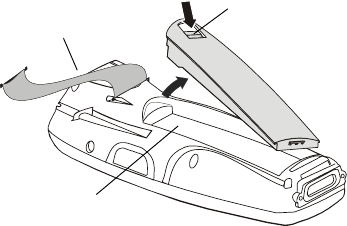
8
Battery Replacement
When the battery’s capacity is critically low, the HC700-G
automatically enters "Critical Low Battery" state and shuts
down all functions (the screen turns off) to preserve the data
in its memory. The HC700-G allows you to replace batteries
without losing information stored in its memory. To avoid los-
ing data stored in the memory, a charged battery must be
installed within 30 minutes.
To replace a battery perform the following steps:
1. Make sure that the HC700-G is powered off (See “Turn-
ing Off” on page 11.).
2. Remove the HC700-G hand-strap (see Figure 4).
3. Press the battery snap on the battery (see Figure 4) and
pull away the battery from the HC700-G.
4. Insert a fresh battery, bottom end first, into the battery
compartment.
5. Carefully, press the battery top downward until it clicks
and locks in place.
6. Press the Power Button - the HC700-G is now ready for
use.
Figure 4. Battery Installation and Removal
Hand-strap
Battery Snap
Battery Compartment
Enhanced IMD Users.book Page 8 Monday, February 12, 2007 11:46 AM

9
Battery Safety
The battery or HC700-G may carry warning symbols, defined
as follows:
Important safety information will follow.
Your battery or HC700-G should not be disposed of in a fire.
To prevent injury or burns:
• USE ONLY SPECIFIED BATTERIES AND CHARGERS - RISK OF EXPLO-
SION IF BATTERY IS REPLACED BY AN INCORRECT TYPE!
• DO NOT DISPOSE OF ANY BATTERIES IN FIRE, AS THEY MAY
EXPLODE!
• DO NOT PUNCTURE OR ALLOW METAL TO CONTACT THE BATTERY
CONTACTS
• DO NOT DISPOSE OF IN WATER
• DO NOT DISASSEMBLE
Battery Maintenance
The performance of the battery depends on the way the bat-
tery is treated. Therefore, to comply with Motorola Warranty
for batteries and to assure high performance and a long life
for the rechargeable battery, please read and follow the bat-
tery maintenance instructions described in the following sec-
tions.
Battery Storage
Batteries which have already been charged and then stored
for more than two months should be recharged before use.
Use the following guidelines for battery storage:
• Before storage, the capacity level of the battery must be
over 30%
• The battery must be recharged over 30% once every six
months
• The battery must be stored in dry location
• Optimal storage temperature is 68°F (20°C)
Do not store batteries installed inside the HC700-
G. Used batteries must be removed from the
HC700-G before storage.
!
Caution
Enhanced IMD Users.book Page 9 Monday, February 12, 2007 11:46 AM

10
Extending Battery Life
Battery performance depends on many factors, including the
temperature at which you operate your handheld computer;
the features and/or settings you select and use; peripherals
attached to the computer and other application usage pat-
terns.
Batteries are expendable parts and gradually wear down and
require longer charging times. This is normal. If you charge
your battery regularly and notice a decrease in usage time or
an increase in charging time, then it is probably time to
switch to a new battery.
To ensure maximum service life of the HC700-G, always
replace the battery with a genuine Motorola replacement.
Battery Disposal
Batteries must be recycled or disposed of properly in accor-
dance with local requirements. Recycling facilities may not
exist in all areas. Please contact your local environmental
agency for more information regarding proper disposal.
To prevent injuries or burns, do not allow metal
objects to come in contact with or short-circuit the
battery contacts.
!
Caution
Enhanced IMD Users.book Page 10 Monday, February 12, 2007 11:46 AM

11
Using the HC700-G
Starting to Work
Place the battery in the HC700-G to boot-up and press the
Power Button (see Figure 1) to turn on the HC700-G; the
Motorola logo will show for about 30 seconds and Windows
Mobile screen will appear. The Windows Mobile screen will
instruct to tap on the screen and to follow the Align Screen
procedure (touch screen calibration).
Turning Off
Turn off the HC700-G when not in use for long duration and
when charging is not available.
Important: When the HC700-G is out of the cradle, do not
attempt to turn off the unit when the Status LED (inside the
Power button) shows red. Pressing the Power button when
the Status LED shows red (system initialization), may cause
damage to the operating system.
Turning off when the unit is on
If the unit is turned on (the screen is on), perform the
following:
Hold down the Power button for at least four seconds
until the screen turns off - the Status LED should be off.
The HC700-G will store the information of the last used
program screen and will turn off. No information will be
lost from the memory. Once turned on again, the HC700-
G will return to the last program screen that previously in
use.
Turning off when the unit is in Suspend mode
If the unit is in Suspend mode (the screen is off and the Sta-
tus LED flashes green), perform the following:
1. Resume operation by momentarily pressing the Power
button.
2. Wait for five seconds.
3. Hold down the Power button pressed for four seconds
until the screen turns off.
Enhanced IMD Users.book Page 11 Monday, February 12, 2007 11:46 AM
12
Resuming Operation
Whenever the HC700-G screen is off, press the Power Button
(see Figure 1) to resume operation.
Important: When the battery is critically drained, operation
can not be resumed by pressing the Power button. The
HC700-G automatically turns off the screen and Status LED.
The unit maintains its memory content until charged again. To
resume operation, place the HC700-G for charging or replace
battery.
Suspend Mode
Use Suspend mode as often as possible during daily use to
conserve battery power. For power saving, the HC700-G will
automatically turn to Suspend after 1 minute (default). To
configure the time duration before the HC700-G enters Sus-
pend mode, go to: Start Menu -> Settings -> System -> Power
-> Advanced (duration range is 0 to 5 minutes).
To manually shift to Suspend mode - while the HC700-G is
turned on, momentarily press the Power Button (see Figure
1).
During Suspend mode the display turns off and the status
LED inside the Power Button slowly flashes green. To resume
operation, momentarily press the Power Button again.
In Suspend mode, the battery power is conserved by auto-
matically turning off the display and the computer sections of
the HC700-G. During Suspend mode, the radios in use con-
tinue to operate. When the HC700-G resumes operation, it
returns to the program screen shown prior to entering Sus-
pend mode.
Enhanced IMD Users.book Page 12 Monday, February 12, 2007 11:46 AM
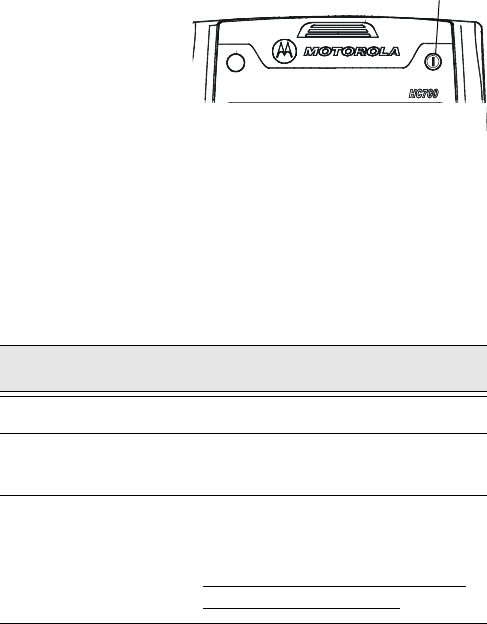
13
The Status LED
The status LED,
located inside the
Power Button (see Fig-
ure 5), may show three
colors to indicate the
HC700-G power sta-
tus.
The Status LED indications are not identical and have differ-
ent meaning when the HC700-G is used outside of the cradle
and when docked in the cradle.
LED indications when HC700-G is used out-
side of the cradle
Table 1: Status LED indications when HC700-G is used out of the Cradle
Status Description
Slowly flashing green HC700-G is in Suspend mode
Fast flashing green with
off interval
HC700-G display is off
Steady red for 6 seconds HC700-G is resuming from critical off
or power off.
Important!: to avoid system failure,
do not remove the battery when the
LED illuminates steady red.
Status LED
Figure 5. HC700-G - Status LED
Enhanced IMD Users.book Page 13 Monday, February 12, 2007 11:46 AM
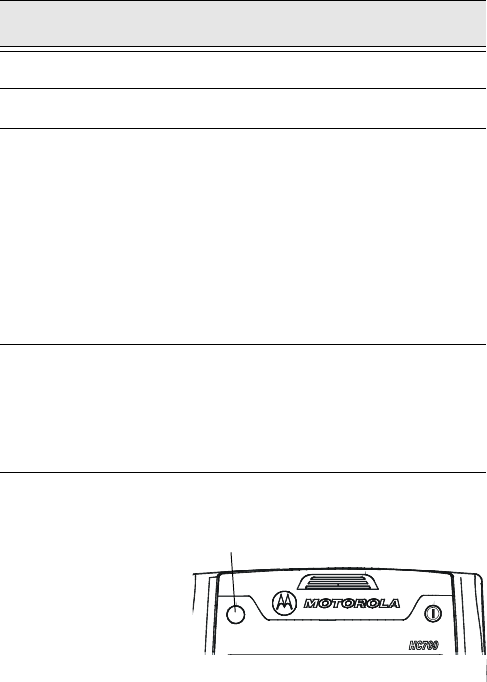
14
LED Indications when HC700-G is docked in
the cradle
The Application LED
The Application LED
(see Figure 6) may be
used for any kind of
application notifica-
tion. For example; the
LED may show com-
munication indication
when the application establishes connection with a host
computer or indicate an alert that needs to be handled. For
more information, refer to your software application guide
and the HC700-G Software Development Kit (SDK).
Table 2: Status LED indications when HC700-G is docked in the Cradle
Status Description
Steady red Battery is charging
Steady green Battery is fully charged
Flashing amber 1. Battery temperature is out of range -
battery charging has stopped. Charging
will resume when battery temperature
is within range.
2. Battery Voltage is out of range
(drained battery). The cradle will
attempt to initiate charging for 20 min-
utes and than stop if unsuccessful.
Flashing red/green Charging error/defective battery.
Remove the HC700-G from the cradle
and dock it back again.
If the LED begins to flash red/green,
within 20 minutes, replace the battery.
Figure 6. HC700-G - Application LED
Application LED
Enhanced IMD Users.book Page 14 Monday, February 12, 2007 11:46 AM
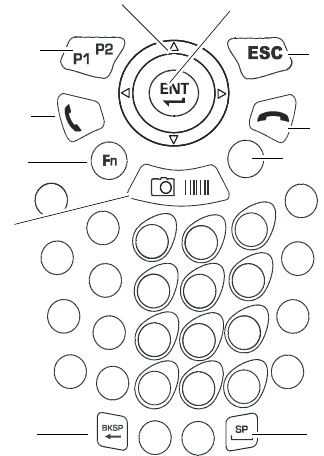
15
Using the Keypad
The HC700-G keypad enables the user to enter both alpha-
betic and numeric data to the software application. However,
since the keypad can only contain a limited number of keys,
some special keys are assigned to perform special tasks that
are usually found on full-size computer keyboards. These are
produced using a combination of the existing keys on the
HC700-G keypad.
Two sets of keys exist on the HC700-G:
1. Keys active when in Alphabetic mode, which are those
seen on the overlay of the HC700-G keypad.
2. Keys active when in Shift or Function mode which are
those seen next to each key on the HC700-G keypad
panel.
Press the <SHIFT> key to toggle between the Alphabetic and
Numeric keypad modes. Figure 7 shows the HC700-G keypad
and Table 3 describes the HC700-G keys assignment.
S
M
G
B
YZ
X
R
L
CDE
HI
A
JK
NOPQ
TUV
W
12
456
9
87
0
F2
F4
F3
F5
F6
F7
F8
/
‘
;
!
@
&
$
F10
F12
F11
^
-
+
,
.
*
#
F1 ?
TAB
F
3
F9
%
Figure 7. HC700-G - Keypad
4-Way Navigation Key Enter Key
Space Key
Backspace Key
End Key
Escape Key
Shift key (yellow)
TAB/Send Key
Function Key
Main
Scan/Picture
Button
Application Key
Enhanced IMD Users.book Page 15 Monday, February 12, 2007 11:46 AM